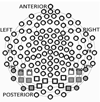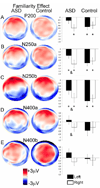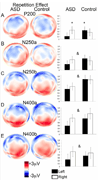Response to familiar faces, newly familiar faces, and novel faces as assessed by ERPs is intact in adults with autism spectrum disorders
- PMID: 20452382
- PMCID: PMC2902604
- DOI: 10.1016/j.ijpsycho.2010.04.011
Response to familiar faces, newly familiar faces, and novel faces as assessed by ERPs is intact in adults with autism spectrum disorders
Abstract
Individuals with autism spectrum disorders (ASD) have pervasive impairments in social functioning, which may include problems with processing and remembering faces. In this study, we examined whether posterior ERP components associated with identity processing (P2, N250 and face-N400) and components associated with early-stage face processing (P1 and N170) are atypical in ASD. We collected ERP responses to a familiar repeated face (Familiar), an unfamiliar repeated face (Other) and novel faces (Novels) in 29 high-functioning adults with ASD and matched controls. For both groups, the P2 and N250 were sensitive to repetition (Other vs. Novels) and personal familiarity (Familiar vs. Other), and the face-N400 was sensitive to repetition. Adults with ASD did not show significantly atypical processing of facial familiarity and repetition in an ERP paradigm, despite showing significantly poorer performance than controls on a behavioral test of face memory. This study found no evidence that early-stage facial identity processing is a primary contributor to the face recognition deficit in high-functioning ASD.
Copyright 2010 Elsevier B.V. All rights reserved.
Figures






Similar articles
-
ERP responses differentiate inverted but not upright face processing in adults with ASD.Soc Cogn Affect Neurosci. 2012 Jun;7(5):578-87. doi: 10.1093/scan/nsp002. Epub 2009 May 19. Soc Cogn Affect Neurosci. 2012. PMID: 19454620 Free PMC article.
-
Developmental change in the ERP responses to familiar faces in toddlers with autism spectrum disorders versus typical development.Child Dev. 2011 Nov-Dec;82(6):1868-86. doi: 10.1111/j.1467-8624.2011.01656.x. Epub 2011 Oct 17. Child Dev. 2011. PMID: 22004249 Free PMC article.
-
Revisiting the earliest electrophysiological correlate of familiar face recognition.Int J Psychophysiol. 2017 Oct;120:42-53. doi: 10.1016/j.ijpsycho.2017.07.001. Epub 2017 Jul 4. Int J Psychophysiol. 2017. PMID: 28684327
-
Repetition effects in human ERPs to faces.Cortex. 2016 Jul;80:141-53. doi: 10.1016/j.cortex.2015.11.001. Epub 2015 Nov 18. Cortex. 2016. PMID: 26672902 Review.
-
The faces of development: a review of early face processing over childhood.J Cogn Neurosci. 2004 Oct;16(8):1426-42. doi: 10.1162/0898929042304732. J Cogn Neurosci. 2004. PMID: 15509388 Review.
Cited by
-
Eye-tracking, autonomic, and electrophysiological correlates of emotional face processing in adolescents with autism spectrum disorder.J Autism Dev Disord. 2013 Jan;43(1):188-99. doi: 10.1007/s10803-012-1565-1. J Autism Dev Disord. 2013. PMID: 22684525 Free PMC article.
-
Neural Mechanisms of Cognitive-Behavioral Therapy for Aggression in Children and Adolescents: Design of a Randomized Controlled Trial Within the National Institute for Mental Health Research Domain Criteria Construct of Frustrative Non-Reward.J Child Adolesc Psychopharmacol. 2016 Feb;26(1):38-48. doi: 10.1089/cap.2015.0164. Epub 2016 Jan 19. J Child Adolesc Psychopharmacol. 2016. PMID: 26784537 Free PMC article. Clinical Trial.
-
Event-Related Potential to Conscious and Nonconscious Emotional Face Perception in Females with Autistic-Like Traits.J Clin Med. 2020 Jul 21;9(7):2306. doi: 10.3390/jcm9072306. J Clin Med. 2020. PMID: 32708073 Free PMC article.
-
Kin rejection: social signals, neural response and perceived distress during social exclusion.Dev Sci. 2014 Nov;17(6):1029-41. doi: 10.1111/desc.12191. Epub 2014 Jun 9. Dev Sci. 2014. PMID: 24909389 Free PMC article.
-
Effect of familiarity on reward anticipation in children with and without autism spectrum disorders.PLoS One. 2014 Sep 3;9(9):e106667. doi: 10.1371/journal.pone.0106667. eCollection 2014. PLoS One. 2014. PMID: 25184524 Free PMC article.
References
-
- Barrett SE, Rugg MD, Perrett DI. Event-related potentials and the matching of familiar and unfamiliar faces. Neuropsychologia. 1988;26:105–117. - PubMed
-
- Begleiter H, Porjesz B, Wang W. Event-related brain potentials differentiate priming and recognition to familiar and unfamiliar faces. Electroencephalogr. Clin. Neurophysiol. 1995;94:41–49. - PubMed
-
- Bentin S, Deouell L. Structural encoding and identification in face processing: ERP evidence for separate mechanisms. Cogn. Neuropsychol. 2000;17:35–54. - PubMed
Publication types
MeSH terms
Grants and funding
LinkOut - more resources
Full Text Sources

